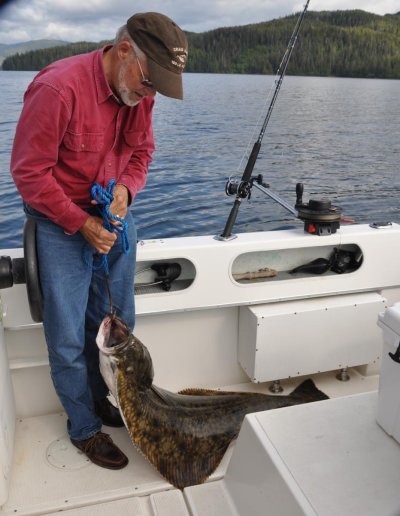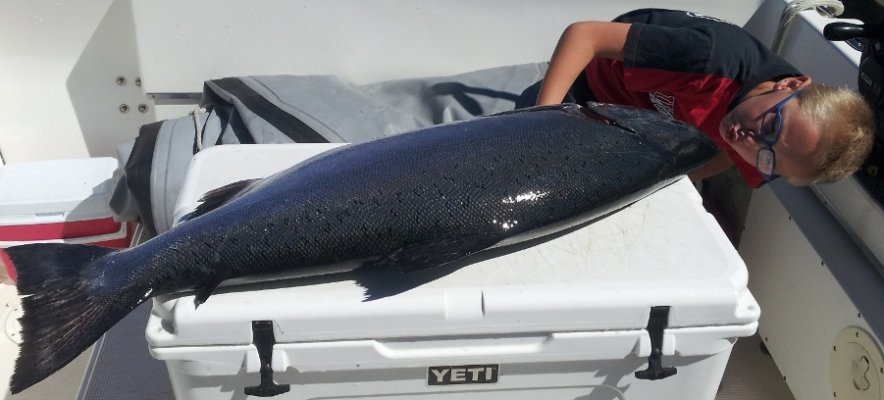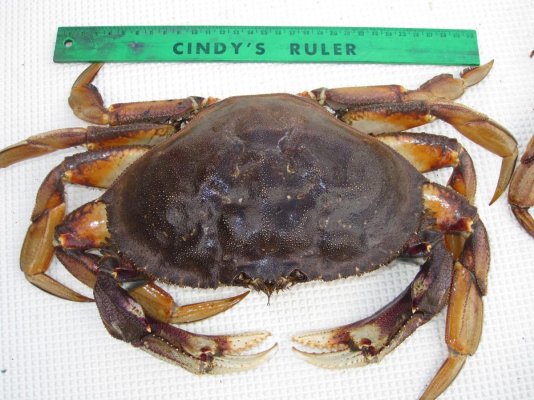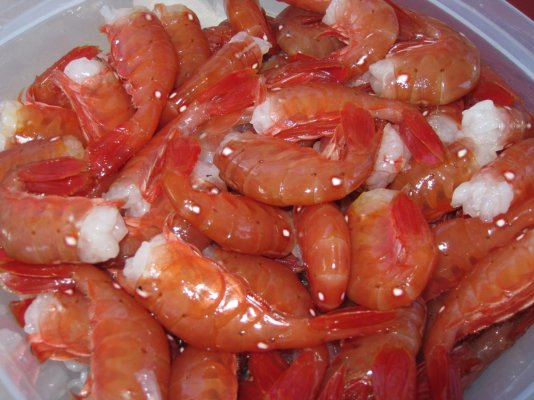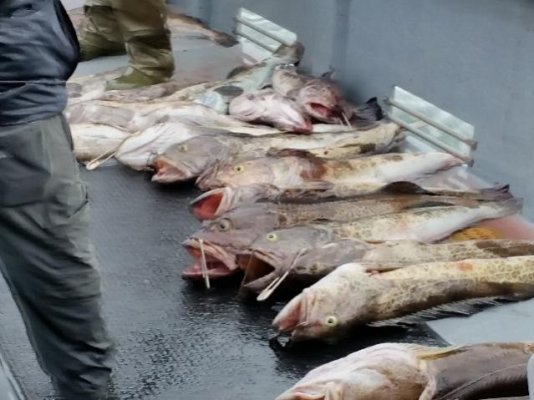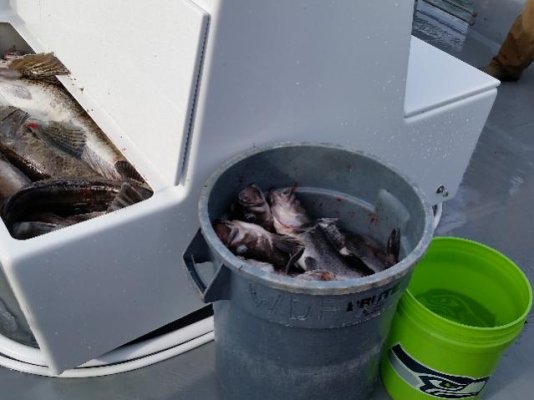Here's an introductory discussion on fishing along the Inside Passage, an excerpt from my book. Since I wrote this, we've become fond of halibut fishing with herring, which we catch using a Sabiki rig if we're in the right location to find them. We fish for King salmon with herring too, in a technique called mooching. Happy to discuss further.
Fishing Gear
Many cruisers enjoy fishing, and in the PNW it’s fairly easy to supply the galley with fresh and delicious seafood. If you’ve never eaten fish caught only hours ago and handled properly, you probably don’t appreciate how good seafood can be.
There are salmon, of course – the quintessential PNW fish. Five species of salmon swim in these waters, but only three you’re likely to catch with rod and reel: Chinook (also known as King), Coho (Silver), and Pink. Chinook and Coho are fine eating, more desirable than Pinks. Chum (Dog) are the least desirable. Sockeye (Red) are caught primarily in commercial nets, but if you’re lucky enough to meet a fisherman with one to spare, accept it gratefully – Sockeye are as tasty as they come.
Another favorite is halibut. These ugly but delicious flatfish range well upward of 200 pounds, but you may not want to keep one larger than 40-50lb (20-25lb of fillets) unless your freezer is unusually large. Since halibut above about 75lb are spawning females, you help sustain the fish population if you don’t keep these really big ones. Our normal practice is not to keep small ones either, giving those under 12-15lb a chance to grow up. If you’re wondering how to figure the weight of a big halibut, just measure its length. Consult the halibut size table found in most tide booklets, and you’ll have a really accurate weight.
Another great PNW delicacy is the Dungeness crab, fairly easily caught in many places up and down the coast. Spot prawns (and smaller shrimp) can be found in many places as well. With most of these critters, the further north, or the further away from civilization, the bigger and more plentiful they tend to be. On our 26-footer, we take the gear to fish for all of these (except for Sockeye). Here’s what we use:
Whether we’re trolling with downriggers for salmon, or jigging for halibut, we like 9-foot graphite “salmon” rods built for 10-20lb or 15-25lb line. Some fishermen use shorter heavyweight rods and big reels for halibut, but we think they’re much stiffer than necessary, and too tiring for jigging. They’re an OK way to go if you fish by anchoring, hooking up a big bait, and letting it sit on the bottom, but we prefer jigging. We’ve caught halibut up to 250lb, jigging with salmon rods. We carry one for each person on board, plus a spare or two.
We use conventional reels, of a size that can hold 240-300 yards of 14lb mono line. Trolling for salmon, we use 17lb or 24lb mono. It’s stretchy, and less likely than braid to pull the hook out of a delicate salmon mouth. For halibut we use similar reels, but spool them with 40 or 50lb braided line. Braid is much tougher than mono, and a lot thinner. Since it’s so thin, the line drags less as it moves through the water, so the current pulls your line out away from the boat less than it would with mono. This makes vertical jigging for halibut (on the bottom in deep water, 100-200 feet or more) much easier. Braid also has very little stretch, so you can feel your jig thumping the bottom, or a fish striking it, even 200 feet down.
For halibut baits, we’re partial to big (8, 12, or 16 oz.) lead-head jigs, with 10” curly-tail grubs. All-metal jigs work well too, but they tend to get expensive, since the bottom often manages to snag a jig or two. Jigs are considerably more effective when tipped with a piece of octopus (or squid as a second choice). Octopus can be found at some PNW fishing suppliers, or in some grocery store freezer sections. We drop our jigs to the bottom, then repeatedly lift up several feet and let them flutter back down, thumping the bottom again after each lift.
If you’re lucky enough to bring in a big halibut, be careful. A 40-50 pounder can thrash around in the cockpit with destructive force. You’ll want to subdue it with a good weighted fish bonker before bringing it over the side. You’ll need a gaff to handle it, because it’s not practical to bring halibut larger than about 15lb aboard in a salmon net. We use a “wireman’s gaff”, which is a big shark hook spliced onto a poly line, so that it can be cleated onto the boat. It works quite well, and takes much less space than a halibut harpoon or gaff with a big handle.
Whether halibut or salmon, bleed it out (by cutting under its gills) as soon as possible after you bring it in, then gut or fillet it, rinse with clean seawater, and get it iced down while it’s still cold. This is key to keeping fish in prime eating condition. We put fillets in zip bags, suck out the air, and stash them in fridge or freezer. A good sharp fillet knife (we like a 10” slightly curved semi-flexible blade) is essential. Sharpen it at least every time you’re about to begin a filleting job.
[FONT="]
[/FONT] For crab, there are two ways to go: pots (traps), or rings. If you’re in a location where you have good reason to believe the Dungies are around, crab rings are a fast way to scoop up a few.
Bait them (fresh salmon heads are hard to beat), drop to the bottom in 20-40 feet of water, and come back after 25-30 minutes. Pull quickly, and the ring, which lies flat when on the bottom, becomes a basket which the crabs can’t easily escape. Rings really work - on one lucky pull, one of our rings brought up fifty Dungies, nine of them keepers (males only, at least a certain size). A plastic crab gauge, designed to handle the various sizes required in different areas, makes measuring quick and easy.
If you have time to soak them (usually at least a few hours), crab pots are the thing. Drop them in 20-40 feet, or occasionally deeper. Pay close attention to where you are on the tide, and where the tide will be when you come back for your pots. Various folding crab pots are available, but the solid round ones are less trouble and work really well, if you have space enough to store them. We like the stainless Ladner pots.
Shrimping is something like crabbing, using pots with smaller mesh and entry doorways. The pots go way deep (150-300 feet or more), so they’re at risk of floating away with tide and current. They’re much safer if weighted with at least a few pounds of lead. The pot line that works for us is a tightly wound ¼” three-strand poly. It’s not really sinking line, but it doesn’t tend to float or tangle nearly as much as the cheaper braided poly line. We splice big loops on both ends of each line, so they’re quick and easy to connect to either pot or float. 300 or 350 feet of line stores nicely on one inexpensive orange plastic power cord reel.
Bait shrimp pots with fresh salmon heads if you have them, or with commercially made bait pellets. As the pot is on its way to the bottom, clip on a line weight, which keeps extra line from floating on the surface and getting caught by a prop. We always use a good bit of extra line, to allow for the tide, and for the fact that in current the line will not run straight up and down. We loop the top end of the line onto a big orange ball fender, mark the location with a GPS waypoint, and let the pot soak overnight.
The next morning we pull pots by warping the line three times around the drum side of our windlass, and winding the line onto its reel as the windlass brings it up (first we loosen the gypsy so it doesn’t turn with the drum). Believe it or not, this whole operation can be done by one person. It sure beats pulling 300 feet of line and pounds of shrimp pot by hand. Folks who do lots of crabbing or shrimping sometimes have dedicated pot-puller machines.
As you might imagine, all this equipment takes a lot of space, and weighs a good bit too – especially downriggers and their weights, and crab and shrimp gear. You’ll have to work out just how much you want to haul. On our C-Dory we carried rods and reels, downriggers, and crab rings, but no shrimp or crab pots.
[FONT="]
[/FONT] If you prefer to carry minimal fishing gear, you could troll for salmon without downriggers, using weights or divers to force the line down behind the boat. A 4-6 oz. weight with a Coyote spoon or an Apex, trolled some distance behind the boat, works pretty well for Coho. Another salmon technique that avoids downriggers is called “mooching”. It’s like drifting and jigging on the bottom, except that it is done up higher in the water column, using live herring for bait. You could also try jigging with artificial baits like crippled herring or buzz bombs, usually higher in the water column like mooching. You could get along with only rods, reels, weights and baits for halibut and salmon. If you like crab, we’d definitely suggest taking at least a couple of crab rings.





 )
)


